Whether you are stockpiling food for emergencies or want backpacking meals, freeze dried food is almost always the best way to go. Freeze-dried foods are lightweight, can last decades, are easy to rehydrate, and taste good.
However, there is one little problem: buying freeze dried foods can cost a fortune.
But did you know that you can freeze dry food at home?
There are now some models of home freeze dryer machines available. If you want to try this at home, here’s what you need to know (including whether it’s worth the cost!).
What Is Freeze Drying?
We know that ice (a solid) can turn into water (a liquid) and then into vapor (a gas). However, in certain circumstances, ice can completely skip the liquid form and turn directly into a gas.
This process of a solid turning directly into a gas is called sublimation.
Freeze drying uses sublimation to remove water from food. The scientific name for this food preservation method is lyophilization.
History of Freeze Drying
Some cultures have utilized sublimation as a natural food preservation method. For example, the people of the Andes Mountains used sublimation to preserve meat and crops as far back as 1200AD. The conditions in the high-altitude Andes Mountains meant that the food froze, then the frozen water in the food slowly sublimated.
During WWII, freeze drying was used to transport blood and organs. Later on, freeze drying was industrialized and used for food. (Sources: 1, 2, 3, 4)
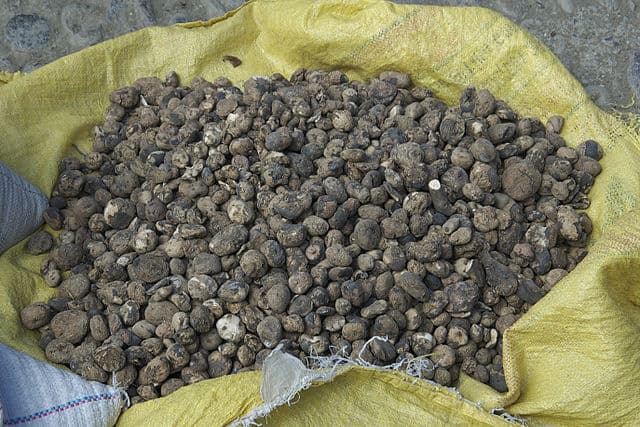
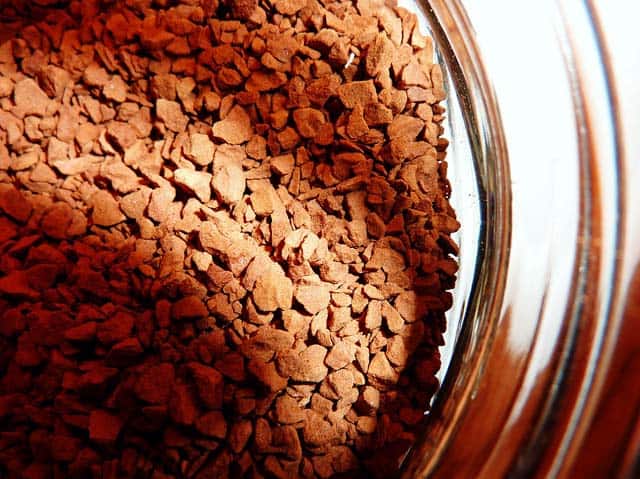
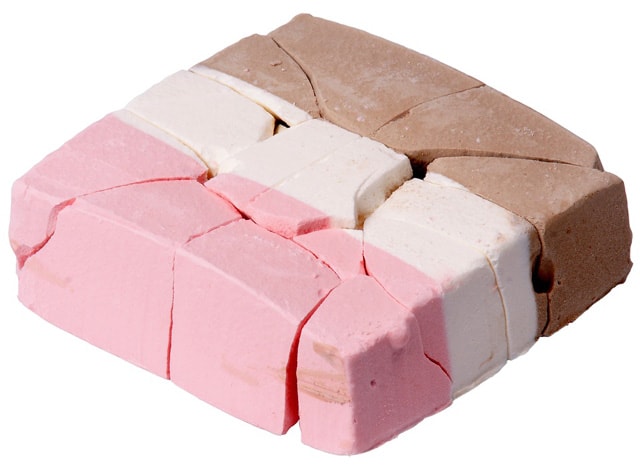
Freeze Drying At Home
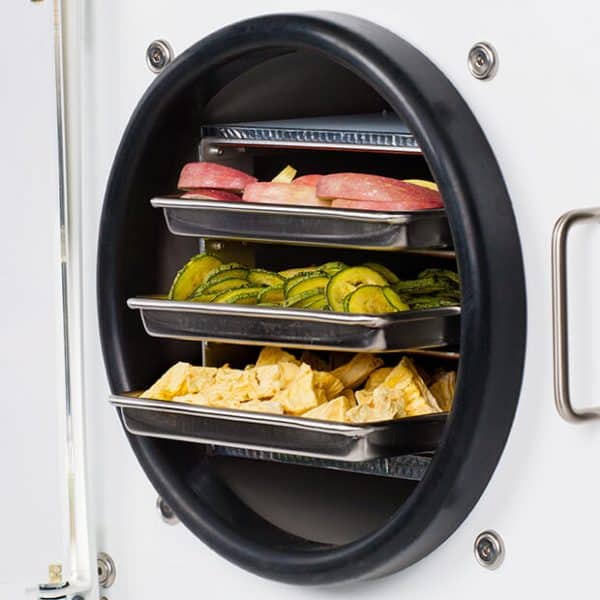
You can preserve food at home in as little as 20 hours with a freeze dryer machine.
The process works like this:
- You put food into the freeze dryer chamber.
- The machine flash freezes the food, so the water inside it turns to ice. Harvest Right units go to -30°F or colder.
- A pump removes air from the chamber, creating a vacuum.
- Because pressure is low inside the vacuum, the ice turns into vapor.
- A low-temperature condenser pulls the vapor out of the chamber.
When the process is over, you will have food that is free of water and chemically stable. So long as you keep the food in ideal conditions, it can last up to 25 years.
The best home freeze dryer machine will self-monitor the process. Once the water vapor has been removed, the humidity sensors automatically turn off, so the method is virtually foolproof.
The freeze dryer will even cycle the temperatures up and down, repeating sublimation until all water is removed from the food.
Can You Freeze Dry At Home without a Machine?
You know the freezer burn that occurs on food when kept in the freezer for a long time? This is the same thing as freeze drying.
So, in theory, you can freeze dry foods simply by keeping them in your freezer long enough.
Some people (such as here) even claim to use their freezers for freeze drying. However, there are some practical problems with using this method:
- It takes a VERY LONG TIME: It will probably take months to freeze dry food entirely in a standard freezer. Not a very effective way to preserve food.
- Only the surface of the food will freeze-dry: Because the pressure isn’t very low in a freezer, sublimation will only occur on the food’s surface. That makes it impossible to freeze dry thicker foods. For example, herbs and greens might work okay, but you can forget about freeze-drying whole strawberries – it takes too long. Even herbs will take about a week to freeze dry.
- Bacteria aren’t killed: Freeze drying (whether in your freezer or with a machine) will not kill bacteria. This isn’t a problem with a professional machine because it removes all water (and thus prevents bacteria from growing). You can’t be sure that all moisture was removed from freezer-burned meat, though, so bacteria could keep growing while it is stored.
There are ways of DIY freeze drying using dry ice or liquid nitrogen. The results will be better, but it still isn’t practical.
So, while you can try it as a fun experiment, don’t count on DIY freeze dry methods for building your emergency food stockpile. (Source 5, 6)
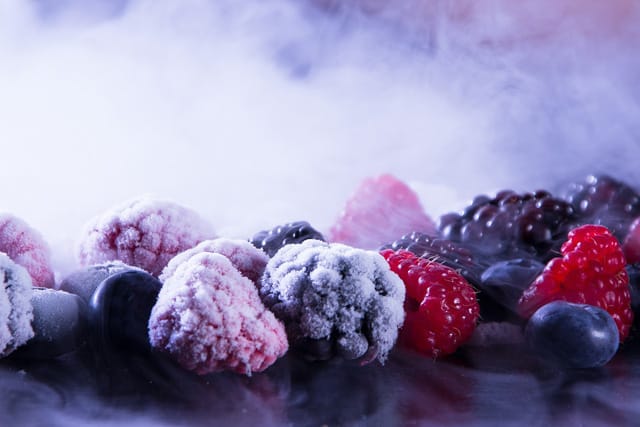
Building a DIY Freeze Dryer
If you don’t want to pay for a professional freeze drying machine, you could try to build one yourself. However, this is not a project for amateurs! You’ll need a lot of (expensive) equipment and knowledge. The video below gives you an idea of how involved the process is.
The bottom line? You’ll need to buy a machine if you want to freeze dry food at home. It’s just not practical to use your home freezer to do it.
Benefits of Home Freeze Drying
Compared to other food preservation methods, there are a lot of benefits to freeze drying. The big ones are;
1. Retain the Nutrients in Food
Compared to other food preservation methods, freeze drying does a great job of preserving nutrients in food. Harvest Right reports these stats:
- Freeze dried foods retain 97% of nutrients
- Dehydrated foods retain 60% of nutrients
- Canned foods retain 40% of nutrients
Of course, Harvest Right (which sells home freeze dryers) has a vested interest in saying that nutrients are retained. But these stats are backed up by many tests.
For example:
- This study in the International Journal of Molecular Science found that freeze drying retained antioxidants such as beta carotene and linoleic acid in most fruits tested
- Sheffield University found that freeze-dried fruits retained 100% of vitamin C and only lost 8% of total antioxidants.
Freeze drying is great for preserving nutrients because vitamins and antioxidants are susceptible to heat. Most vitamins are also water-soluble, so they can be lost in the liquid used in canning.
2. Better Taste and Texture
Ever tried a freeze-dried strawberry? It is delicious and crisp. I like them more than fresh strawberries. Freeze-dried peas are so crunchy that you could smuggle them into the movies to eat instead of popcorn.
Now, not all freeze dried foods taste good – especially when you rehydrate them. My thru-hiker father constantly complains about how gross freeze-dried lasagna is (I’m not sure why he keeps bringing it on his hikes!).
Yes, the texture can get a bit weird when you rehydrate freeze-dried foods. But, compared to canned or dehydrated foods, the texture is generally much less mushy.
You can check out our review of the top freeze-dried food brands to get the lowdown.
3. Shelf Life
Freeze dried foods can have an amazingly long shelf life. Some foods will last over 25 years, assuming you keep them away from light and moisture.
Of course, canned foods also have a long shelf life. However, home canning usually involves glass jars – and glass is not the best storage vessel for emergency prep (imagine all your food prep shattered everywhere after an earthquake, hurricane, or tornado!).
4. Lightweight
Because all the moisture is removed, it is very lightweight. It is even lighter than dehydrated food because some moisture remains after dehydration. A good home freeze dryer machine will have humidity sensors and only stop the process once the food is completely dry.
The lightweight means freeze dried foods are ideal for backpacking and Bug out Bag planning.
Read our suggestions for Bug Out Bag Foods.
Freeze Drying vs. Dehydrating
Freeze drying is often compared to dehydrating. While both methods remove moisture from the food to preserve it, they are very different.
One isn’t necessarily better than the other – they serve different purposes. Read more about freeze dried vs. dehydrated.
Here’s a breakdown of how they compare.
| Freeze Drying | Dehydrating | |
|---|---|---|
| Shelf Life | Up to 25 years | 1-5 years |
| Weight | Very lightweight | Lightweight |
| Taste and Texture | Most foods retain their taste and texture when rehydrated | Taste usually remain the same when rehydrated but the texture gets mushy |
| Drying Time | 20-48 hours | 4-12 hours |
| Rehydrating | 5 minutes or less | 3-20 minutes |
| Nutrient Content | Almost all nutrients remain | About 60% remain |
| Cost of Machine | Expensive | Cheap |
| Practicality | Easy process, but machines are loud and require some maintenance | Simple to learn and machines are easy to care for. |
Again, neither method is “better” than the other – it depends on your goals and budget. For example, I love dehydrated fruit leather but prefer freeze-dried fruits in my cereal.
To learn more about dehydrating food, read this complete guide to dehydrating every food type.
What Types of Foods Can Be Freeze Dried?

Almost all foods can be safely freeze dried. However, foods that have high water content tend to work best. These include:
- Tree fruits like apples and plums
- Berries
- Fruits like tomatoes, peppers, zucchini, and pumpkin (yes, they are fruits!)
- Root veggies like carrots and potatoes
- Most cooked or blanched veggies
- Eggs – how to freeze dry eggs
- Grains
- Cooked pasta
- Cooked beans and legumes
- Condiments that don’t contain too much sugar
- Entire meals, soups, or sides (so long as they don’t contain too much oil, fat, or sugar)
What Foods Don’t Freeze Dry Well?
While you can freeze dry these foods, they don’t always come out well.
- Greens like spinach, kale, and lettuce: They end up wilted and soggy. (how to preserve kale)
- Raw vegetables: You generally need to cook or blanch veggies first, or they will be very tough when freeze-dried.
- Very sweet fruits like peaches: You can still freeze dry them; they just take a very long time because their sugar content is so high.
- Big pieces of food: It will take a very long cycle. Plus, the texture will be weird, and it will take a long time to rehydrate.
- Fruits with tough skins: The tough skin on fruits like cherry tomatoes and grapes makes it difficult for moisture to get out of the fruit. The solution? Cut the fruits in half before you put them in your freeze dryer!
- Very watery fruits: Fruits like watermelon don’t work well. Once all the water is removed, there is almost nothing left. They lose their structure, and you end up with a powder.
Foods which CANNOT Be Freeze Dried
There are two types of foods that cannot be freeze-dried:
- High-fat foods, such as peanut butter, fatty meat, breakfast sausages, avocado, and mayo.
- Foods with a lot of sugar, such as jams and sweet relish.
If you try to freeze dry fatty foods, the fat will melt. You will end up with a disgusting greasy coating inside your freeze dryer machine!!!
As for sugary foods, the issue is that sugar binds to water. So, the water will get trapped inside any sugary foods. Natural fruits are generally okay (though very sugary fruits will take a long cycle). Don’t try to freeze dry jams or jellies, though.
Shelf Life
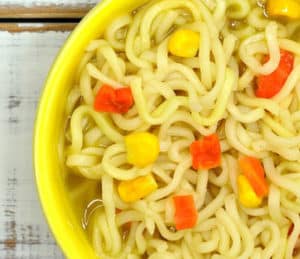
Freeze dried foods have all their moisture removed. Without moisture, bacteria and mold cannot grow – the food can last for decades. This is why packages of freeze-dried foods often list their shelf life of 25+ years.
However, there is moisture in the air. If you store your foods in baggies or jars, some moisture from the air will re-enter the food. Light and heat will also cause the food to degrade. Eventually, the food will start to go bad.
To keep their freeze-dried foods from going bad, companies will package them in air-tight bags with all the oxygen removed. Once you open the packaging, you’ll need to use the food within 1 year. If it’s damp outside, the food might only last a week or two!
So, it’s safe to say that home freeze-dried foods won’t last more than a year if they aren’t packaged properly. If you want to use freeze drying for long-term food storage, you’ll have to take the time to store it properly.
How to Package Freeze Dried Foods for Long-Term Storage
If you want your home freeze dried foods to last 25+ years, you’ll need to ensure that humidity, oxygen, and light aren’t reaching them. The easiest way to do this at home is:
- Put the food in Mylar bags
- Add oxygen absorbers
- Seal the bags
- Keep the bags somewhere safe from rodents and damage
You can read a detailed description of how to do this here in our post about using mylar bags for food storage. The process is the same for dehydrated foods and freeze dried foods.
Another option is to put the food in canning jars with oxygen absorbers. This is good if you plan on rotating through the freeze dried foods within a year or two. For emergency planning, you wouldn’t want to rely on glass jars.
Downsides of Home Freeze Drying Machines
Home freeze dryers are cool and arguably the best way to preserve food. But, before you buy a home freeze dryer, you need to know about the downside;
1. The Machines Are Huge!
Even the smallest dryers are about the size of a mini-fridge. They are also VERY heavy. If you want to share it with another family, you’ll need to rig a wheeled cart for the freeze dryer. Otherwise, you’ll break your back trying to move it.
2. They Are Loud
Harvest Right freeze dryers are loud – about the level of a vacuum cleaner. When running, you’ll probably want to keep it somewhere like your basement or garage.
3. Maintenance Required
When a machine costs as much as a used car, you should expect it to require some maintenance. You’ll need to regularly maintain the freeze dryer, mainly with the vacuum pump. You’ll need to:
- Change the oil after every 5-7 batches – read about how to change the oil
- Do a power flush after every 10-12 batches
- Clean the interior of the machine regularly
4. Oil Spraying
One common problem is that oil can spray. This is because the oil level in the pump is finicky and hard to get perfect.
Once the machine is turned on, the oil level will increase a bit because of motion. The hot oil can then mist or splatter all over the place. This also happens if the pump malfunctions and can’t create a vacuum.
This problem is so common that Harvest Right recommends putting a sock over the vent to prevent oil spray. It is still messy though, and you’ll need to continually check the oil level between batches to avoid spraying. There is also an option of paying more for an oil-free pump, which would prevent this problem altogether.
5. Home Freeze Dryers Cost a Fortune
Compared to other home food preservation methods, freeze drying costs a fortune. Even the smallest machines cost as much as a used car to buy.
This leads us to;
Are They Worth the Cost?
The biggest downside to home freeze dryers is the cost. At the time of writing, the cheapest Harvest Right model is $1995. The mid-sized is $2495, and the large size is $3195.
But packages of freeze-dried foods are also costly. So, I did some math to determine how long it would take for a Harvest Right freeze dryer to pay for itself.
First, I looked at the cost of cans of freeze-dried beef, strawberries, and peas.
#10 Can of Freeze-Dried Beef
- Typically costs about $45 (for pure meat – not the cheap meat, which is basically fillers)
- Rehydrated, you get about 4.4lbs of beef
- You are paying about $10.22 per pound of rehydrated beef
- By comparison, fresh beef costs about $5/lb in supermarkets
#10 Can of Freeze-Dried Strawberries
- Typically costs around $25
- Rehydrated, you get about 5lbs of strawberries
- You are paying about $5 per pound of rehydrated strawberries
- By comparison, fresh or frozen strawberries typically cost about $2.50/lb in supermarkets
#10 Can of Freeze-Dried Peas
- Typically costs around $22
- Rehydrated, you get about 3.3lbs of peas
- You are paying about $6.67 per pound of rehydrated peas
- By comparison, fresh or frozen peas typically cost about $1.50/lb in supermarkets
Based on these three products, we can calculate that, on average:
- Cans of freeze-dried food cost $7.30 per pound of rehydrated food
- The supermarket price for this food averages $3.00 per pound.
Let’s say that you buy the medium-sized Harvest Right freeze dryer. It holds 7-10lbs (or 8.5lbs average) per run. Now let’s say that you use it once per week on average.
So…
- 8.5lbs of food x 52 batches = 442lbs of food
- The average price per pound for supermarket food is $3 per pound. So, you paid $1326 for the actual food. The price of the dehydrator is about $2495. That means the cost of the DIY freeze-dried foods is $3821.
- Buying this amount of freeze-dried food would have cost you approximately $3,227 (442lbs x $7.30).
*Bear in mind that these are rough calculations. Many variables (like whether you buy in bulk, grow your food, seasons, food prices where you live, cost of electricity…) will affect the ROI.
Based on these calculations, buying cans of freeze-dried foods is cheaper. And that’s without even factoring in the cost of electricity, oil, time, and storage bags/oxygen absorbers!
However, a home freeze dryer DOES pay off…
- If you use it more than once per week on average
- After the first year
- You grow your food or buy fresh foods in bulk at a discount
- If you are freeze drying meals since these tend to be much more expensive per weight than single ingredients.
The average machine should perform for many years, and as a long-term investment, they can certainly offer value for money.
Too Expensive for You Now?
I recommend you see if you can split the cost with another family. You can take turns using it. The freeze dryer will pay off much faster, with the initial costs divided in half.
Or, you can wait until the cost of home freeze dryers gets cheaper. Remember when home computers used to cost over $1000? As the technology advanced and PCs became more popular, the costs dropped drastically.
You could also look for a used freeze drying machine. However, I don’t like to buy expensive equipment that is no longer covered by a warranty. You have no idea whether the former owner took good care of the freeze dryer. If it breaks after you buy it, there’s nothing you can do. New freeze dryers are pricey – but at least they are covered by a warranty.



Is it possible to get a #10 can of freeze dried food, open it, and put it in smaller portions in Mylar bags? Is an OA needed at that point?
Any comments are appreciated. Thank you
Yes — you could do that but you would need to put OAs into the Mylar bags with the food. Honestly, I would never repackage a #10 can of food (assuming it has OAs or is nitrogen-flushed). It’s already packaged in a way which will keep it good for decades. Why mess with that?
If you ever do have to crack open the #10 cans, you could always repackage any uneaten leftover food in Mylar + OA after the emergency has passed.
The price has come down from 5,000. I’m considering getting one. What I want to know is how much does it cost to run a batch?
That would require a bunch of math to figure out. Amount of electricity used x price of electricity x amount of time it would take to run. Obviously it would cost more to dry wet foods like milk or yogurt than drier foods like bananas.
Diane Vuković
You’re amazing! I recently found this site looking for how to tell if MREs are good. I’ve got an old batch eating now; I’ll reply if I get get sick, you know, for the sake of science.
This site is incredible with non- commercial, home science studied prepper hacks to learn with.
Thank you and keep it up!
Glad you are finding it helpful. I eat “expired” food all the time (used to dumpster dive when in college too!) and haven’t ever had issues. 😀
FYI, most freeze dryers have an option to run the vacuum pump manually. This allows you to vacuum seal mason jars. Take your dried food, put it in a jar with the lid on loosely. Run the vacuum pump. When you release the vacuum, the air pressure will seal the mason lid, and you just have to tighten the ring. No oxygen absorber needed.
I was buying freeze dried food for my long term food storage and within a few months had spent $2000. Since I wasn’t even close to the half way mark on the amount of storage I wanted to have on hand, I bought a freeze dryer. Wish I had of done it way sooner. You mentioned to not do watermelon, but it is amazing. Even a so so watermelon comes out great. It holds it’s shape well. I can hardly keep it on the shelf. My family loves it so much.
I think I’ll wait until more companies make them, it sounds like an awesome way to preserve. But when our food stock gets close to expiration date, within a few months we donate it to others
The oil spraying problem can be solved two ways:
1. By proper maintenance and operation of the unit
2. By upgrading to an oil free pump (my choice) Approx $1200.00 to $1500.00
Worth it in my humble opinion
I will wait until there’s more than one company making them. Just like computers; competition drove the price down. Plus I’d want someone to solve the spraying oil problem.
I agree…you hit the nail right on the head…
I have a Harvest Right Medium freezer and I love it. I started freeze drying blueberries–we have a blueberry farm. A pain to do because you need to pin prick each berry but delicious. Went on to other fruit. Now am freeze drying meat. Will be drying meals next. It is fun and after a year, I know I am breaking even. BTW food tastes great!!!
I own a large freeze dryer and really do think it will more than pay for itself in a short time.
For doing blueberries get a brand new horse grooming brush, with a head on it meant to push the curried hair out of the brush. Push the brush down on multiple berries, expel with the push head and repeat.
Would a picky man eat the meat? I’m being serious when I ask. Like how well it reconstitutes?
I use to live in remote/bush alaska. I am planning on moving back.
We use to preserve our meat and berries by freezer. Electricity cost is outrageous and many brown outs occured out there. When we wanted to go out of town, we always had to have someone babysit the house in fear of brownouts ruining our stock.
We also lived off- grid at times and we would have to run the generator for so long in the summer just to keep the freezer food froze. (gas for generator cost $13/gal)
To me it sounds like we should consider freeze drying in stead of freezing our berries and meat (mainly moose and caribou which is lean, would salmon freeze dry?) If we make the move back. Esp with inflation costs.
Would you kindly take the time to tell me any thoughts you have for me to consider?
I did my most important growing up in the Alaska out on the Aleutians. We typically smoked the salmon and I will try to freeze dry some in a couple of weeks (store bought now that I am on the East coast). As far as leaner meats (including large and small game) we found it best to freeze dry cooked as a meal component. ground meats work well and re-hydrate to a great consistency. If you have some tallow, lard, or other stored fat that you can use to carry what ever flavor you are looking for, it works event better. Tacos and chili are two favorites here. For other meats, the greater the surface area to volume, the better if dries and subsequently re-hydrates. For the larger meat items, I have them incorporated into meals ready to re-hydrate. I also found the pealed de-veined cooked shrimp work really well and are excellent for adding to soups/stews.